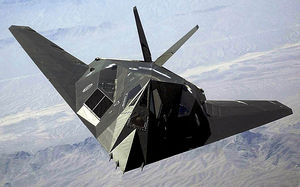F-117
The F-117 Nighthawk, simply called the black jet by its crews, was the first operational stealth aircraft. While it was designated as a fighter, it has no air-to-air armament, and probably was called a fighter simply because fighters tend to be more prestigious in the United States Air Force. Its first major operational use was in the Gulf War; F-117s were the only manned aircraft allowed to fly into the extremely strong Baghdad-area KARI integrated air defense system (IADS).
History
Rather ironically, the fundamental technical principles of the low-radar-observability aspects of stealth aircraft came from an unclassified theoretical paper, written in 1966 by a Soviet microwave researcher.[1]
Developed in extreme secrecy by the "Skunk Works" advanced development facility, now part of Lockheed Martin.[2]
The F-117A production decision was made in 1978 with a contract awarded to Lockheed Advanced Development Projects, the "Skunk Works," in Burbank, Calif. The first flight over the Nevada test ranges was on June 18, 1981, only 31 months after the full-scale development decision.[3]
The first F-117A was delivered in 1982, and the last delivery was in the summer of 1990. Air Combat Command's only F-117A unit, the 4450th Tactical Group, (now the 49th Fighter Wing, Holloman Air Force Base, N.M.), achieved operational capability in October 1983.
Sensors
To maintain stealth, the F-117 can use only passive sensors. That usually means that the precise location of the target is known at mission planning time, and, at most, the pilot might use electro-optical guidance (e.g., low-light or infrared television) to fly a weapon to an exact spot.
If there is a need for attacking a target whose position is uncertain, the target will need to be designated by laser, from a special reconnaissance team on the ground or possibly an aircraft with active sensors.
Weapons
The aircraft has a bomb bay that typically holds two precision-guided munitions, usually guided bombs using inertial (e.g., JDAM), television (e.g., GBU-15), or laser guidance (e.g., GBU-24 PAVEWAY III)
Combat
For short-range missions, the F-117 is being replaced by the F-22 Raptor. The first 10 were retired in December 2006. [3] For longer-ranged missions against even harder IADS, the B-2 Spirit will take on the Black Jet's mission.
Panama
its first use was in Panama, not because there were serious Panamanian air defenses, but because it could provide the necessary accuracy for one specific mission.
Gulf War
During Operation Desert Storm in 1991, F-117A's flew approximately 1,300 sorties and scored direct hits on 1,600 high-value targets in Iraq. It was the only U.S. or coalition aircraft to strike targets in downtown Baghdad. Since moving to Holloman AFB in 1992, the F-117A and the men and women of the 49th Fighter Wing have deployed to Southwest Asia more than once. On their first trip, the F-117s flew non-stop from Holloman to Kuwait, a flight of approximately 18.5 hours -- a record for single-seat fighters that stands today.[3]
Balkans
In 1999, 24 F-117A's deployed to Aviano Air Base, Italy, and Spangdahlem AB, Germany, to support NATO's Operation Allied Force. The aircraft led the first Allied air strike against Yugoslavia on March 24, 1999.[3]
The only F-117A to be shot down was brought down by the Serbian integrated air defense system. While no definitive analysis has been published, it has been suggested that the aircraft maneuvered to avoid the radar from a SA-6 GAINFUL, which brought it into visual (or electro-optically assisted visual) observation by anti-aircraft artillery or a fighter.
Iraq War
Returning to the skies over Baghdad, F-117A's launched Operation Iraqi Freedom with a decapitation strike on March 20, 2003. Striking key targets in the toppling of Saddam Hussein's regime, 12 deployed F-117s flew more than 100 combat sorties in support of the global war on terrorism.
General characteristics
- Primary Function: Attack
- Contractor: Lockheed Aeronautical Systems Co.
- Power Plant: Two General Electric F404 non-afterburning engines
- Thrust: 18,080 pounds at sea level
- Wingspan: 43 feet, 4 inches (13.2 meters)
- Length: 63 feet, 9 inches (19.4 meters)
- Height: 12 feet, 9.5 inches (3.9 meters)
- Weight: 52,500 pounds (23,625 kilograms)
- Maximum takeoff weight: 47,900 pounds (21,727 kilograms)
- Fuel capacity: 19,000 pounds (8618 kilograms)
- Payload: 4,000 pounds (1,814 kilograms)
- Speed: High subsonic
- Range: Unlimited with air refueling
- Ceiling: 45,000 feet (13,716 meters)
- Armament: Internal weapons carriage
- Crew: One
- Unit Cost: $45 million
- Initial operating capability: October 1983
- Inventory: Total force, 45
References
- ↑ Ufimtsev, P. Ya., Method of Edge Waves in the Physical Theory of Diffraction, AD0733203
- ↑ Rich, Ben R. & Leo Janos (1996), Skunk Works: A Personal Memoir of My Years of Lockheed, Back Bay
- ↑ 3.0 3.1 3.2 3.3 "F-117A Nighthawk factsheet", Air Force Link
